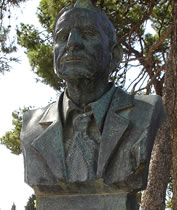




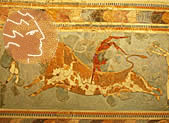
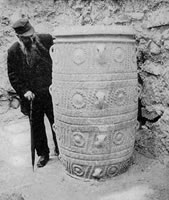

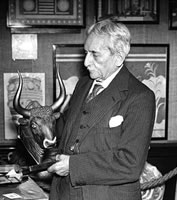
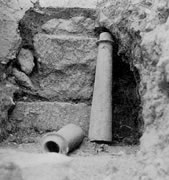
Sir Arthur John Evans and the excavation in Knossos
Sir Arthur John Evans (8/7/1851-11/7/1941) was an English archaeologist who discovered the basis of the Minoan civilization, which during his day was a faint mythical memory. He was the son of John Evans a paper industrialist and amateur archaeologist of Welsh descent. Educated at Harrow at Brazenrose college and at the university of Goetingen .He espoused his fathers interest in archaeology and worked at the Ashmole museum in Oxford during the period 1884-1908.
Sir Arthur John Evans in Crete
Evans was especially interested in Crete because it was the source of the seals which bearing primal uncoded engravings.
The ancient city of Kefala (Knossos) on the north coast near Heraklion was known to the locals as the place where they unearth ancient ceramics and ornate coins as they cultivate their fields. Nevertheless the first person to excavate Knossos was actually an Heraklion man called Minos Kalokairinos who in 1878 discovered the foundations of storage spaces, full of pytharia (gigantic jars). Kalokairino’s work was recorded by a William Stilman a U.S. ambassador to Crete at the time, indicating that the findings belonged to the western wing of the palace. Apart from the storage areas Kalokairinos excavated a section of the “Hall of the throne”foundations.
However the Turkish owners of the area soon stopped Kalokairino’s research. Then Heinrich Schlieman the famous German archaeologist attempted to buy the “Hill of Kefala” which in reality was a ‘toumba’ or an artificial tomb or pile created from successive overlapping structures built on top of the previous residences of Knossos, dating from the Neolithic era. Schlieman had to abandon the idea because of the astronomically high prices demanded by the owners.
In 1894 Evans visits Crete to study and decipher two types of unknown writing which appeared on the Cretan seals. A year later he published his findings under the auspices of the Ashmole museum, the title of which is Cretan hieroglyphics and pre-Phoenician writing (Evans 1895) thereby now acknowledged as the Linear A and B language tablets.
The excavation in Knossos
The political changes that Crete underwent facilitated Evans’ desire to start excavations after the Cretan revolution. In 1899 using money inherited from his parents Evans buys the property in Kefala, utilizing a huge working force for those times, undertakes large scale and systematic excavation of the site. By the end of 1903 he discovers a major part of the foundations of an extended complex which he identifies as the palace, the centre of the Minoan civilization. Not only did Evans discover the buried ruins, published (1921-1935) in four volumes, encompassing King Minos’ Knossos palace, regarded as a classic work in archaeology but he also maintained them with state of the art methods (of his time) and succeeded in partly restoring them.
In the restoration effort Evans used foreign material like cement. Inevitably he was criticized by people who believed that the means and materials used should have been similar to the ancient ones. Nevertheless Evans’ effort literally helps the average visitor today even, to ‘read’ the archaeological site. Thus despite that the results still annoy present day researchers Evans’motives in this case are fully justified.
In addition to the pioneering excavation work of the palace area the more significant discoveries of Evans relate to the 3.000 Linear A and B language tablets. Linear B has been proven to be the primal form of the Greek language from the sub-Minoan period, whereas Linear A is the language of the Minoans which remains undeciphered until today.
Evans was knighted in 1911 for his services in the archaeology of Knossos and the Ashmolean museum.The excavation work in Knossos ( the property which Evans bought to maintain and conserve from destruction), is still continuing actively today under the British archaeological school in Athens.
e-book The prehistoric tombs of Knossos (1906) by Sir Arthur Evans
Sir Arthur John Evans (8/7/1851-11/7/1941) was an English archaeologist who discovered the basis of the Minoan civilization, which during his day was a faint mythical memory. He was the son of John Evans a paper industrialist and amateur archaeologist of Welsh descent. Educated at Harrow at Brazenrose college and at the university of Goetingen .He espoused his fathers interest in archaeology and worked at the Ashmole museum in Oxford during the period 1884-1908.
Sir Arthur John Evans in Crete
Evans was especially interested in Crete because it was the source of the seals which bearing primal uncoded engravings.
The ancient city of Kefala (Knossos) on the north coast near Heraklion was known to the locals as the place where they unearth ancient ceramics and ornate coins as they cultivate their fields. Nevertheless the first person to excavate Knossos was actually an Heraklion man called Minos Kalokairinos who in 1878 discovered the foundations of storage spaces, full of pytharia (gigantic jars). Kalokairino’s work was recorded by a William Stilman a U.S. ambassador to Crete at the time, indicating that the findings belonged to the western wing of the palace. Apart from the storage areas Kalokairinos excavated a section of the “Hall of the throne”foundations.
However the Turkish owners of the area soon stopped Kalokairino’s research. Then Heinrich Schlieman the famous German archaeologist attempted to buy the “Hill of Kefala” which in reality was a ‘toumba’ or an artificial tomb or pile created from successive overlapping structures built on top of the previous residences of Knossos, dating from the Neolithic era. Schlieman had to abandon the idea because of the astronomically high prices demanded by the owners.
In 1894 Evans visits Crete to study and decipher two types of unknown writing which appeared on the Cretan seals. A year later he published his findings under the auspices of the Ashmole museum, the title of which is Cretan hieroglyphics and pre-Phoenician writing (Evans 1895) thereby now acknowledged as the Linear A and B language tablets.
The excavation in Knossos
The political changes that Crete underwent facilitated Evans’ desire to start excavations after the Cretan revolution. In 1899 using money inherited from his parents Evans buys the property in Kefala, utilizing a huge working force for those times, undertakes large scale and systematic excavation of the site. By the end of 1903 he discovers a major part of the foundations of an extended complex which he identifies as the palace, the centre of the Minoan civilization. Not only did Evans discover the buried ruins, published (1921-1935) in four volumes, encompassing King Minos’ Knossos palace, regarded as a classic work in archaeology but he also maintained them with state of the art methods (of his time) and succeeded in partly restoring them.
In the restoration effort Evans used foreign material like cement. Inevitably he was criticized by people who believed that the means and materials used should have been similar to the ancient ones. Nevertheless Evans’ effort literally helps the average visitor today even, to ‘read’ the archaeological site. Thus despite that the results still annoy present day researchers Evans’motives in this case are fully justified.
In addition to the pioneering excavation work of the palace area the more significant discoveries of Evans relate to the 3.000 Linear A and B language tablets. Linear B has been proven to be the primal form of the Greek language from the sub-Minoan period, whereas Linear A is the language of the Minoans which remains undeciphered until today.
Evans was knighted in 1911 for his services in the archaeology of Knossos and the Ashmolean museum.The excavation work in Knossos ( the property which Evans bought to maintain and conserve from destruction), is still continuing actively today under the British archaeological school in Athens.
e-book The prehistoric tombs of Knossos (1906) by Sir Arthur Evans
